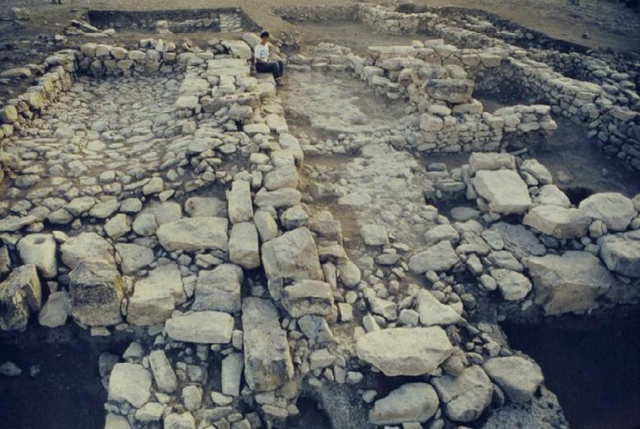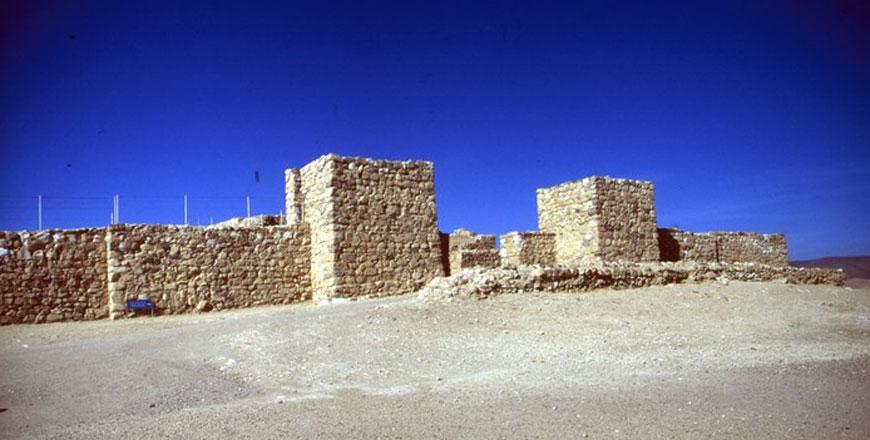You are here
About Levantine Bronze Age: Theories on archaic urbanism
By Saeb Rawashdeh - Apr 22,2024 - Last updated at Apr 22,2024

Khirbet Iskander was a Bronze Age site in central Jordan whose original name is lost in history (Photo of Bashar Tabbah)
AMMAN — For decades, many scholars have attempted to connect the Bronze Age with urbanism in the Levant and some of the archaeologists and historians have perceived this period as the initial phase of urbanisation. We are referring to the late fourth or early third millennia BC, when similar processes were occurring in Egypt, Mesopotamia and the areas that were politically dependant on these two centres.
“In other words, the Early Bronze II–III walled sites of the southern Levant are not ‘urban’ in the classic sense, as represented by the primary states,” noted Suzzane Richard, an American archaeologist who studied sites in the Madaba Plain.
Richard believes that the urban centres would include a wealthy elite; four-tiered organisational hierarchies; vast cities with large populations; state-sponsored craft specialisation; significant surpluses; international exchange and far-flung dispersion of identifying cultural markers; and, especially, the presence of writing.
“Newer approaches, in fact, are now questioning whether the Early Bronze data sets — including fortified sites, settlement hierarchies (which hint at socio-political hierarchies), public buildings such as palaces and temples, large storage facilities; craft specialisation, interregional and international exchange networks, moderate evidence for elites, moderate evidence for a system of notation (sealings and potmarks), cultural uniformity suggestive of integrative mechanisms, floral, faunal, and climatic data, and, frankly, contrast with the EB I/EB IV periods — truly reflect urbanism, particularly when judged against Mesopotamia,” Richard explained.
Many researchers came with different conclusions about urbanism and archaic cities.
“The first theory focuses on so-called ruralism,” Richard explained, adding that “On the basis of his excavations at Abu an-Ni’aj [EB IV] and Tall Hayyat [EB IV–Middle Bronze] in Jordan, along with an analysis of deep-time settlement patterns, Falconer believes that ‘rural complexity and autonomy’ —not classic Mesopotamian urbanism— were the fundamental characteristics of the Canaanite society. Classic urbanism involves a high level of political and economic control exerted by the centre over satellite and hinterland sites [e.g. Mesopotamian city-states].”
“In this model, EB II–III walled sites are considered ‘epiphenomena’ within a rural heartland.
They represent a rare experiment in increased complexity [central sites/cities] within a predominantly rural system. Even during such times, the rural sites are only loosely related to the cities and towns, preferring to remain autonomous,” Richard underlined adding that, “This model neatly explains the unique character of EB II–III ‘urbanism’.” It also provides an explanation for the continuation of the rural settlements in the post-collapse [EB IV] period: since the rural sites are independent and not fully integrated with central sites, they can adapt to turbulent periods and are less likely to collapse.
“In the latest conceptualisation of the model, based on site cluster analysis, Falconer and others now question whether city-states or cities even existed in the Early Bronze in Jordan, and throughout the southern Levant.”
Another model is the so-called heterarchy where Philip argues that Jordan’s Early Bronze Age (and the southern Levant, in general) is not characterised by urbanism, but rather exemplifies a corporate type of political organisation.
“Rather than the hierarchically organised urban setting where elites dominate and control the city, its satellites, and the rural area politically and economically, the EB II–III walled sites are more like independent “corporate villages”,” the scholar maintained, adding that the political structure is based on a type of shared (i.e. horizontal power) communal organisation in which individual households bind together, probably along kinship lineages, the outgrowth of which being the corporate village.
“Although kinship lineages are hierarchically ranked, parallel lineages would share power, with perhaps the strongest clans asserting themselves. Complementing the ‘corporate village’ view, several settlement studies find little evidence for integration of sites and also opt for the heterarchy as an explanatory model Harrison’s work in the Madaba Plains is premised on the view that, rather than scale [i.e. site size and settlement hierarchy], the more pertinent method to investigate political and economic organisational strategies is to focus on the level of regional integration of the sites,” Richard pointed out.
The third theory is the so-called great and little traditions or interconnectivity, which is a long-term study of cultural interaction that goes from the Early Bronze Age until the Ottoman Period.
According to Richard, it focuses on discerning not just the impact of elite or “great” traditions (e.g. Egyptian and Mesopotamian empires) on local or indigenous cultures, but also the essential components of each tradition.
Oysten LaBianca developed this framework to help explain the cyclical episodes of sedentarisation / nomadisation against the historically documented great traditions that have swept over Jordan and/or influenced local polities and traditions.
“LaBianca’s testing of the model in the Madaba Plains found diverse, heterarchical organisational strategies — such as those observed in kinship patterns, both tribal and at the household level — rather than centralised hierarchical patterns,” Richard underscored.
Related Articles
AMMAN — The Early Bronze IV (c. 2,500- 2,000BC) in the ancient Near East was marked by a systematic change.
AMMAN — Bayesian modelling, a method of statistical analysis, applied to Radiocarbon dating, has changed perceptions of the Early Bronze Age
AMMAN — Ancient burial sites provide an abundance of information that are normally lacking due to lost written sources, if there were any.



















